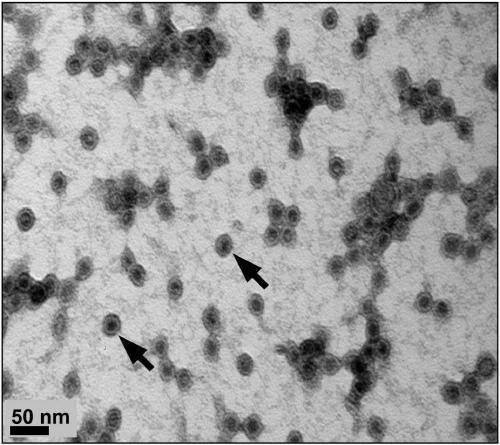Pasteurella multocida toxin recombinant protein, virus-like particle thereof and use thereof
A virus-like particle and Pasteurella technology, applied in the direction of anti-bacterial immunoglobulin, virus, application, etc., can solve problems such as death, high pollution rate, and liver damage
- Summary
- Abstract
- Description
- Claims
- Application Information
AI Technical Summary
Problems solved by technology
Method used
Image
Examples
Embodiment 1
[0067] Example 1 Construction of Pasteurella septica toxin recombinant protein (re-PmT)
[0068] 1. Design of the amino acid sequence of Pasteurella septica toxin recombinant protein (re-PmT)
[0069] Three epitopes were selected from the full-length amino acid sequence of the Pasteurella septica toxin protein (PmT) (as shown in SEQ ID NO: 1), respectively:
[0070] Epitope A: SVGKEGAYYPDHDYGPEYNPVWGPNEQI (SEQ ID NO: 2);
[0071] Epitope B: SISPDDPPREITD (SEQ ID NO: 3);
[0072] Epitope C: LNSTPGTGRPMP (SEQ ID NO: 4).
[0073] Each epitope A (SEQ ID NO: 2), epitope B (SEQ ID NO: 3), and epitope C (SEQ ID NO: 4) are respectively connected with a linker, and the connection The sub has the amino acid sequence shown in SEQ ID NO:11. According to the difference in sequence combination of antigenic determinants A, B, and C from the N-terminus of the recombinant protein from the C-terminus, the amino acid sequences of the obtained Pasteurella septica toxin recombinant protein (re...
Embodiment 2
[0079] Example 2 Culture of Bordetella bronchiseptica and Pasteurella multocida
[0080] 1. Culture of Bordetella bronchiseptica (B.bronchiseptica)
[0081] First inoculate B.bronchiseptica on TSB solid medium [containing 5% (v / v) yeast extract, 10% (v / v) serum, soybean decomposed protein Casein medium (tryptic soy broth, TSB, BD Company, USA)], after culturing overnight at 37°C, a single colony was selected and inoculated in brain heart infusion (BHI) liquid medium (BD Company, USA) ), shake culture overnight at 37°C; then inoculate the bacterial liquid in BHI liquid medium, shake culture overnight at 37°C, and calculate the colony forming unit (CFU) value; finally add formaldehyde (formaldehyde ), shake at room temperature for 24 to 36 hours, and inactivate the bacterial solution.
[0082] 2. Culture of Pasteurella septica (P.multocida)
[0083] Pasteurella septica type A (PmA) and Pasteurella septica type D (PmD) with the ability to produce toxins were first inoculated o...
Embodiment 3
[0084] Example 3 Preparation of porcine atrophic rhinitis immune composition
[0085] Pasteurella septica toxin recombinant protein (re-PmT) (SEQ ID NO: 5) (final concentration: 250 μg / ml) obtained in Example 1 or virus-like particles containing Pasteurella septica toxin recombinant protein ( re-PmT VLP) (SEQID NO:10) (final concentration is 250 μ g / ml) and the inactivated bronchiseptic Bordetella (B. bronchiseptica) obtained in Example 2 (final concentration is 1×10 9 CFU / ml), inactivated Pasteurella septica type A bacteria (PmA) (final concentration is 1x10 9 CFU / ml) and inactivated Pasteurella septicemia type D bacteria (PmD) (final concentration is 1×10 9 CFU / ml) was mixed evenly with phosphate buffered solution (PBS), and aluminum gel [final concentration was 30% (v / v)] was added as an adjuvant to prepare a porcine atrophic rhinitis immune composition.
PUM
 Login to View More
Login to View More Abstract
Description
Claims
Application Information
 Login to View More
Login to View More - R&D
- Intellectual Property
- Life Sciences
- Materials
- Tech Scout
- Unparalleled Data Quality
- Higher Quality Content
- 60% Fewer Hallucinations
Browse by: Latest US Patents, China's latest patents, Technical Efficacy Thesaurus, Application Domain, Technology Topic, Popular Technical Reports.
© 2025 PatSnap. All rights reserved.Legal|Privacy policy|Modern Slavery Act Transparency Statement|Sitemap|About US| Contact US: help@patsnap.com



